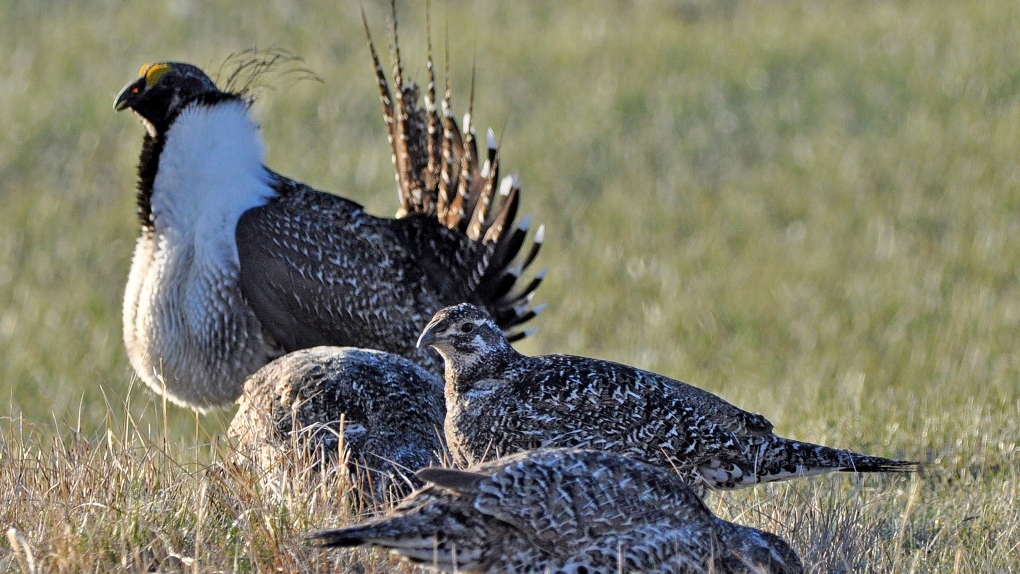Calgary Zoo grouse benefit from Drumheller's flood mitigation program
 This March 1, 2010 file photo from the U.S. Fish and Wildlife Service shows a bi-state sage grouse, rear, as he struts for a female at a lek, or mating ground, near Bridgeport, Calif. (Jeannie Stafford/U.S. Fish and Wildlife Service via AP, File)
This March 1, 2010 file photo from the U.S. Fish and Wildlife Service shows a bi-state sage grouse, rear, as he struts for a female at a lek, or mating ground, near Bridgeport, Calif. (Jeannie Stafford/U.S. Fish and Wildlife Service via AP, File)
Calgary Zoo staff and volunteers arrived in Drumheller on Tuesday to begin harvesting sage that will help support a population of endangered birds that will be settled in the region.
The greater sage-grouse are part of the Wilder Institute/Calgary Zoo's reintroduction breeding program for the species.
Zoo staff had previously made the journey to Drumheller in 2019 to conduct an ecological harvest, taking clippings and trimmings throughout the Drumheller Valley.
"The silver sagebrush found in the Drumheller Valley is an optimal winter food source for the greater sage-grouse," Calgary Zoo habitat supervisor Ryan Neilson said in a press release from the Drumheller Resiliency and Flood Mitigation Office (DRMO).
Greater sage-grouse are the largest grouse species in North America, native to areas of southwestern Saskatchewan and Alberta, and are listed as an endangered species under the Species at Risk Act (SARA).
Wilder Institute is currently the only reintroduction breeding program for these birds in Canada and, as of February, 187 sage-grouse have been released into the wild through the program.
DRFMO says the partnership with the zoo was a "natural partnership that made sense."
This year's harvest will be different from the ecological harvests in the past, as the zoo will have the opportunity to take the whole bush to prevent wasting any part of the plant. Through whole bush harvesting, the zoo may be able to transplant some of the harvested bushes to cultivate their own supply of silver sagebrush.
Indigenous groups were originally consulted at the beginning of the flood mitigation project, though not specifically on this aspect of the project. DRFMO adds it is open to working with Indigenous groups who may be interested in also harvesting sage.
At this time, it is unknown how much plant material the zoo will be able to harvest.
CTVNews.ca Top Stories

Canadian musician Jacob Hoggard found not guilty of sexual assault
Canadian musician Jacob Hoggard has been found not guilty of sexually assaulting a young woman in northeastern Ontario eight years ago. The former Hedley frontman had pleaded not guilty to sexual assault.
Police arrest Toronto woman in connection with three recent homicides
Police have arrested a Toronto woman in connection with three recent homicides and investigators say that they believe two of the victims may have been 'randomly targeted.'
Missing B.C. climber died from fall on Mount Baker, medical examiner says
The body of a British Columbia mountain climber has been located and recovered after the 39-year-old man was reported missing during a solo climb on Washington state's Mount Baker earlier this week.
Following child's death in Ontario, here's what you need to know about rabies and bats
An Ontario child died last month after coming into contact with a rabid bat in their bedroom, which was the first known human rabies case in Canada since 2019.
A French judge in a shocking rape case allows the public to see some of the video evidence
A French judge in the trial of dozens of men accused of raping an unconscious woman whose now former husband had repeatedly drugged her so that he and others could assault her decided on Friday to allow the public to see some of the video recordings of the alleged rapes.
Former Colorado county clerk Tina Peters sentenced to 9 years for voting data scheme
A judge ripped into a Colorado county clerk for her crimes and lies before sentencing her Thursday to nine years behind bars for a data-breach scheme spawned from the rampant false claims about voting machine fraud in the 2020 presidential race.
Anne Hathaway confirms 'Princess Diaries 3': 'Miracles happen'
You might be thinking, 'Shut up!' but it’s officially true: the 'Princess Diaries' franchise is finally growing.
Youth pleads guilty to manslaughter in death of P.E.I. teen Tyson MacDonald
A teen charged with the murder of another teen on Prince Edward Island last year has pleaded guilty to a lesser charge of manslaughter.
Sask. man pleads guilty in U.S. after unknowingly providing videos of men raping toddlers to FBI agent
A Saskatchewan man living in the United States has pleaded guilty to possessing child pornography after he unknowingly provided disturbing videos to an FBI agent he thought was a pedophile.
































